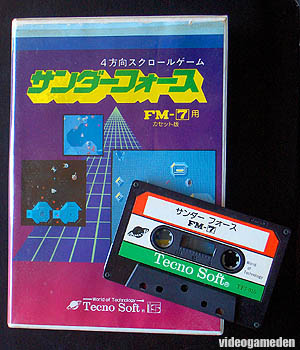 (Click to enlarge)
(Click to enlarge)
|
|
サンダーフォース
Thunder Force is without a doubt a name capable of making any
fan of the shooter genre slightly overheat and cry tears of joy. The now sadly defunct Tecno-soft
blessed the video game world with its awesome series of games, and Thunder Force
is certainly the most popular among hardcore gamers.
The first opus of the series is probably
the most enigmatic of all, and some people even argued that it simply didn't exist and that
Tecno-Soft started their series with Thunder Force 2, just for the sake of it.
But no, this is not what happened, and indeed prequel there is. Many great web sites have now some information about
what really occured back in 1984, but I happened to bump into this FM-7 version and
I though it would be the best opportunity to talk a bit more about Thunder Force.
|
Thunderforce the first was only released for Japanese computers such as the Sharp X1 (and MZ-1500), Fujitsu's FM-7
(ancestor of the FM-Towns computer and Marty console), NEC's PC-8801 (and PC-6001)
and IBM PC-JX. All in all, six or seven versions
apparently exist (as far as we can tell).
Thunder Force is somehow similar to the first part
of Thunder Force 2 - it is a top-view shooter with multidirectional scrolling. A number of enemy
ships and ground buildings need to be cleared before the player can get a change to affront the boss and access the next zone.
Backgrounds are very simple and use a palette of no more than five or six bright colors (of at least in this FM-7 version).
Ships are grey and anything dangerous on screen is on the red side. At least there's not confusion here,
everything is clear and simple.
I was not able to test this FM-7 version and most of the pictures on the cover seem to be
taken from the PC-8801 game (both packaging are virtually identical). As far as I know, the FM-7 version had
a couple of technical limitations though - the screen could only
scroll in four directions (unlike the Sharp's X1's version which could do eight), and the
digitized voice was omitted.
Of course the game design has aged a lot, and the interest of Thunder Force and the technical
limitations will probably confuse and annoy many players out there. But hey ! This is Thunder Force,
and I personally think it is not too bad for a twenty years old game after all. If
we take the effort to put Thunder Force back in the context it belongs to, we
find a fun and more than correct shooter.
|
|
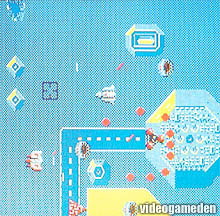
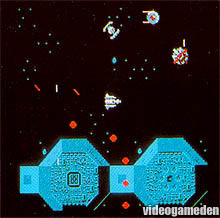
|
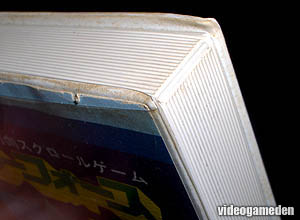
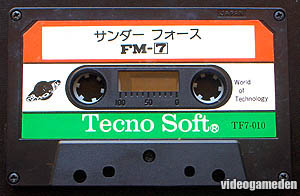
|
|
Ok, that was about the game itself. Let's talk now about the packaging. The box is actually
quite nice and, like many other FM-7 titles, has a sort of 'book' feeling. Understand here that the
side of the box seems to be designed to look like a closed book. Back in 1984, if your parents
were suspicious about the pile of games you brought back from your friend's house, you could always
camouflage them as study books. Just genius. Anyway, I'm just guessing here, but I found this detail amusing
(as a side note, SunSoft games for the Famicom Disk System borrowed exactly the same design).
The game has a small and cheap documentation page (literally a double sided and folded sheet of paper) with detailed
space ships and other fortresses that need to be defeated in the game. But the most interesting
part of all, is the game itself. Twenty years ago, many games came on tapes, and Thunder Force
falls into this category. The same thing applies to the PC-88 version I have seen, both look identical,
only the system logos and serial numbers differ. The other side of the tape is blank though.
|
|
Game's story translated
from the instruction manual
We, the federation army, are in a very disadvantageous situation at
the battle in the Orn planetary system.
The enemies converted a planet into an enormous military fortress Dairadayzer.
It is covered by fake land surface, and it is extremely difficult to attack.
We finally completed building a bombardment space ship Fire-Leo which is specially
designed to destroy their militant stronghold. It is now approaching the asteroid belt
where the enemies await..
Thanks again to Tadao Mihashi for his precious help.
|
|
|
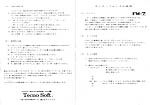
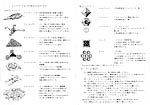
(Click to enlarge)
|
As mentioned earlier, as far as I know six different versions of the
game seem to exist. Here is a non-exhaustive list of all the
known games. This list will be updated, and corrected, as
more information is found. Do not hesitate to contact me if
you would like to contribute.
|
Machine
|
Year
|
Price
|
Format
|
Serial #
|
Miscellaneous
|
|
Sharp X-1
|
1983
|
¥4,800
|
Tape
|
TX4-014
|
-
|
|
Sharp X-1
|
1984
|
¥6,900
|
5¼" Disk
|
TX1-016
|
Level Editor
|
|
Sharp MZ-1500
|
1983
|
¥4,800
|
Quick Disk
|
?
|
-
|
|
IBM-JX
|
1983
|
¥?
|
3.5" Disk
|
?
|
-
|
|
Fujitsu FM-7
|
1984
|
¥4,800
|
Tape
|
TF7-010
|
-
|
|
Fujitsu FM-7
|
1984
|
¥6,900
|
3.5" Disk
|
?
|
Level Editor
|
|
NEC PC-6001mkII
|
1985
|
¥6,900
|
Disk
|
?
|
-
|
|
NEC PC-6001mkII
|
1985
|
¥4,800
|
Tape
|
?
|
-
|
|
NEC PC-8801mkII
|
1985
|
¥6,900
|
Disk
|
TP8-010
|
-
|
|
NEC PC-8801mkII
|
1985
|
¥?
|
Tape
|
?
|
Level Editor
|
Acknowledgments : I would like to thank Adol for the information regarding
the Sharp X1 version.
|
All logos and trademarks
are © their respective owners.
This page content is
©2006 Video Game Den / Laurent KERMEL